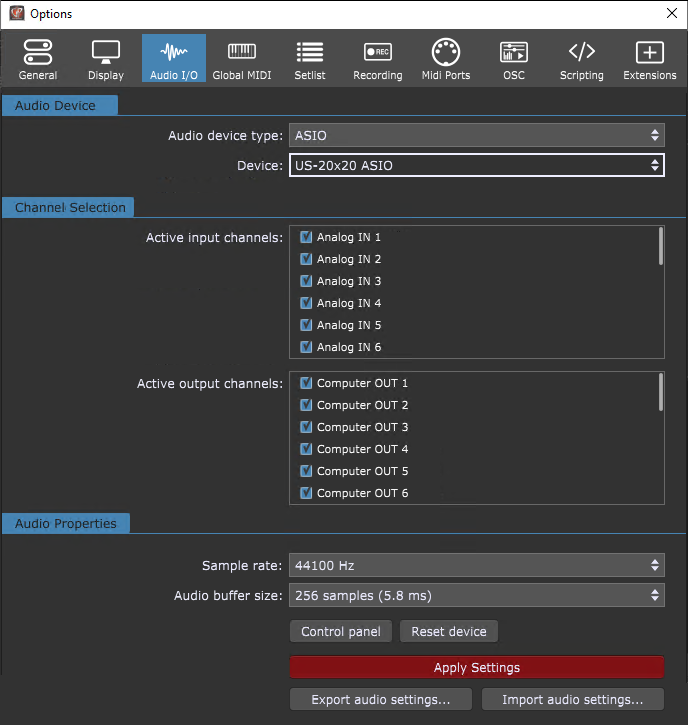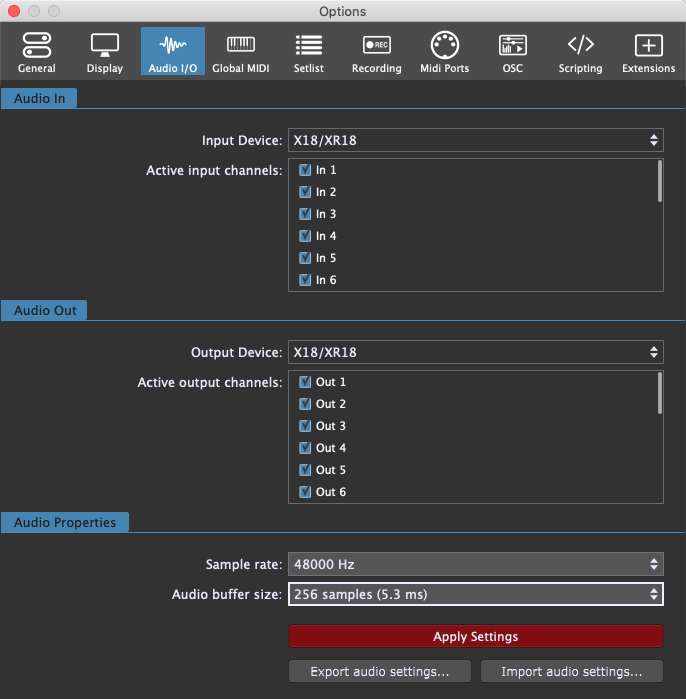The Audio I/O tab appears when the Audio setup menu item is chosen in the Options menu; this window is slightly different on Windows and macOS:
Windows:

MacOS:

On macOS you can separately select the input and output device and there is no device type selector as there is always just one type (Core Audio); on Windows, the audio device type selector is included and one device must be used for both input and output.
Audio device type - for best results on Windows, make sure that you always select ASIO driver.
Device - this drop-down menu allows you to select one of the connected audio interfaces or an aggregate device (consisting of multiple interfaces) such as ASIO4ALL or ASIO Link Pro (if installed). On Mac this section is split into Input Device and Output Device (any aggregate devices created in the Audio MIDI Setup utility will appear here as options as well).
Active input channels/Active output channels - determines how many input and output channels are to be made available to Gig Performer. If you are using an audio interface with many channels, you may not want to access them all. For example, you may have an interface with 8 analog output channels and another 16 Lightpipe (ADAT optical) channels that you're not using. So instead of displaying audio IN/OUT blocks with 24 or more channels, you can disable the ones you don't need by unchecking them in the list.
Tip: holding the Shift key down while clicking on an input or output checkbox will set all of them to the inverse of the one you selected.
Sample rate - the sample rate determines the quality of the audio signal. Typical values in the live world are 44.1kHz and 48kHz. Note that there is a tradeoff between higher sample rates, latency and CPU utilization. To view our website article about audio latency, buffer size, and sample rate, click here.
Audio buffer size - the buffer size determines how often samples are actually processed. The smaller the buffer size (or the higher the sample rate), the lower (better) the latency but at the cost of higher CPU utilization. Depending on your plugins and your computer, you may need to find a compromise that gives you the best tradeoff between CPU utilization and latency. If you start using too many CPU cycles, you will begin to hear clicks and other noise in the output. To view our website article about audio latency, buffer size, and sample rate, click here.
Apply settings - this button will appear if you make any changes to the parameters in this dialog. Click on it to accept the changes, or simply close the Options dialog to maintain the current settings.
Export audio settings and Import audio settings buttons - Gig Performer allows you to export your audio settings and import them back in again. This feature makes is useful for supporting multiple audio configurations. Visit this chapter to learn more about various Gig Performer file extensions and this chapter to learn more about the default file locations in Gig Performer.
Note: changing the audio input or output device requires all plugins to be reset and so will cause your entire gig file to be reloaded immediately. Further, some plugins don't properly handle having their sample rate or buffer size changed after they have been loaded and may crash. Therefore, we recommend that you make such changes using an empty gig file. If you are changing your audio configuration (device, sample rate, buffer size, etc.), it can be useful to start Gig Performer with the Shift key held down, which opens the Temporary Startup Options dialog. Turning off the Load last gig file toggle button temporarily prevents Gig Performer from loading your previous gig file (this applies if the Reload last gig on startup option is enabled in the General Options).